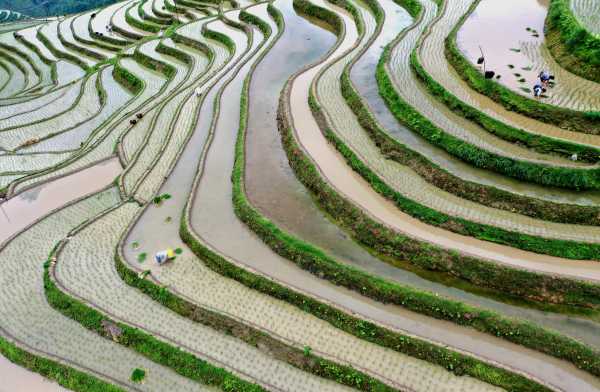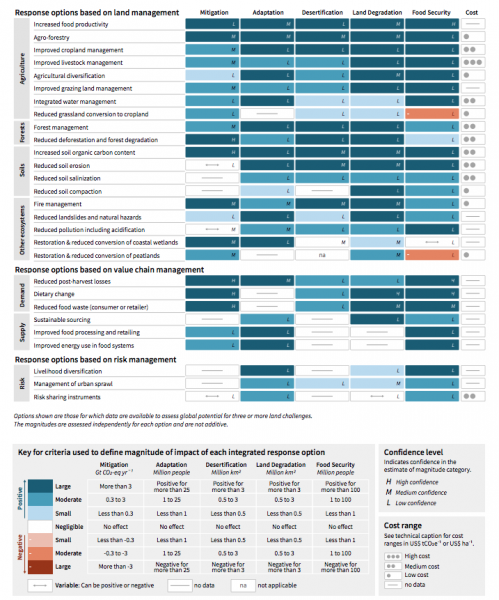
The huge new report from the Intergovernmental Panel on Climate Change on land use is finally out. The conclusions are stark: We are changing the Earth’s lands so drastically that our survival is now threatened.
Though the report rounds up the best science on various climate horrors from intensifying heat waves and dust storms to growing food insecurity, it also devotes an entire 300-page chapter to evaluating land-based solutions and responses to climate change and land degradation.
Such a sweeping problem means that there are a lot of ways to respond. The IPCC sums it all up in one, big, complicated chart:

While a bit cryptic, the chart shows the various ways we can change how we use land, from diversifying crops to managing urban sprawl. It compares these tactics based on factors like how well they limit climate change, how they help us adapt to warming, and what they do for our food supply. Depending on what factor worries someone the most, they can then figure out what are the most effective actions to, say, slow the spread of desertification.
The chart helpfully translates all the research in the IPCC report, which evaluates more than 7,000 studies, into possible policy actions. But if you’re like me and can’t parse all the subtle shades of blue in this figure, here are four key themes from the IPCC’s analysis of using land to combat warming.
We can solve multiple problems at the same time
There are often many different interests that compete over land. Some want to develop it to grow food, some want to make furniture from the trees, some want space to build homes, and some want to keep it as-is to protect wildlife. That often means there are tradeoffs in using land to help mitigate climate change — preserving a grassland might mean there is less land available to grow crops, for example. Or allowing the concrete and asphalt of a city to sprawl out may lead the region to trap more heat.
But there are ways to advance on all fronts at the same time. Tactics like improving food productivity or increasing the carbon content of soil can simultaneously mitigate climate change, help regions adapt to warming, stop desertification, reverse land degradation, and enhance food security.
“The options with medium to large benefits for all challenges are increased food productivity, improved cropland management, improved grazing land management, improved livestock management, agroforestry, improved forest management, increased soil organic carbon content, fire management, and reduced post-harvest losses,” according to the report.
Enhancing food productivity, for example, means using less land for agriculture. That could help preserve forest land that would otherwise have gone to farming, retaining a natural carbon intake system. Those forests then move moisture through the biome and help regulate temperature, reducing the impacts of warming. Trees in the preserved forest anchor the soil, slowing erosion and preventing desertification. That stabilizing effect in turn helps reduce volatility in crop yields, enhancing food security.
Restoration is an active process
Undoing some of the human damage to the landscape can help capture greenhouse gases and make ecosystems more resilient. An example might be converting exhausted and abandoned pasture land back into the grasslands that preceded it.
But restoring ecosystems is complicated, and there’s no guarantee that if we were to step back from a piece of land that nature would recover on its own.
That’s why there’s so much emphasis on the word “management” in the IPCC report. It cites the case study of a restoration of soil and water in Ethiopia’s Tigray region, a notoriously drought-prone and degraded area. Conservation tactics have helped stabilize vegetation in the region, but without ongoing input from local landowners, those gains could be lost. It shows how restoration demands close attention and care.
“Most of the degraded landscapes have been restored, with positive impacts over the last two decades on soil fertility, water availability and crop productivity,” the report states. “However, misuse of fertilisers, low survival of tree seedlings and lack of income from exclosures may affect the sustainability of these land restoration measures.”
All this means that if we want to rebuild a forest, a grassland, or a watershed, we can’t simply hope nature will run its course; we have to take deliberate actions to erase our fingerprints, regenerate the environment, and monitor progress carefully.
Slowing down the pace of destruction can help a lot
One thing you might have noticed in the IPCC chart above is that the word “reduced” appears a dozen times: reduced soil erosion, reduced deforestation, reduced grassland conversion to cropland.
Many natural systems regenerate over time, but right now, much of our extraction outpaces this regeneration. If we were to slow it down enough, the land could become more resilient and become a better reservoir of carbon. Some forms of tilling for agriculture can degrade soil up to 100 times faster than soil is generated, for example.
Similarly, we can also take steps to accelerate the recovery of ecosystems. Improved forest management, for example, entails “a wide variety of practices affecting the growth of trees and the biomass removed, including improved regeneration (natural or artificial) and a better schedule, intensity and execution of operations (thinning, selective logging, final cut; reduced impact logging, etc.),” according to the report (emphasis added).
So we don’t necessarily have to get to zero impact on the land to mitigate climate change, but slowing down how quickly we alter the landscape and letting nature catch up can offset much of the harm from our actions.
At the same time, our voracious appetite for natural resources is closing the window for action. Certain ecosystems like peatlands and rainforests could be degraded until they reach a tipping point where restoration is no longer possible, cascading into further losses. So we have to slow our consumption, quickly.
We throw way too much food away
There’s a fundamental problem in our food system: Up to 30 percent of the food we produce is wasted.
Think about it. Imagine tilling soil, applying fertilizer, planting seeds, irrigating for months, and harvesting a crop only to see almost one-third of it thrown away. This waste has huge environmental costs. Food lost to waste accounts for upward of 10 percent of global greenhouse gas emissions.
If the world were to drastically limit food waste, farmers would need less land, less fuel, less water, and less fertilizer, all of which would translate to a smaller environmental footprint. “Technical options such as improved harvesting techniques, on-farm storage, infrastructure, transport, packaging, retail and education can reduce food loss and waste across the supply chain,” the report states. “By 2050, reduced food loss and waste can free several [million square kilometers] of land.”
We could also use food heading for trash for energy, which would lessen its impact on the climate. However, the IPCC notes that paradoxically there might not be enough food waste to make this a worthwhile pursuit for bioenergy companies.
The best solution then is to simply grow only what we will actually use, and to use all that we grow. Waste not, want not.
Sourse: vox.com






